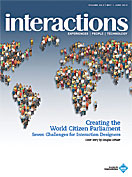Authors:
Jon Kolko
How do you describe your lab to visitors?
Austin Center for Design is an educational institution in Austin, Texas that teaches interaction design and social entrepreneurship. Our program offers a year of methods, theory, and practice that culminates in the development of double-bottom-line businesses: Students create new companies that drive revenue and impact.
What is a unique feature of your lab?
Building empathy is a large theoretical underpinning of our program, and we emphasize participatory and collaborative design processes continually throughout our work. This means that our lab is really the real world. When students focused on solutions to aid the homeless in Austin, they spent time with people experiencing homelessness, caseworkers, legal counsel, businesses that are impacted by those living on the streets, neighbors, tourists, and on and on. A big part of the culture of homelessness in Austin is a weekly gathering called Church Under the Bridge, under Interstate 35, and so our students spent a great deal of time immersed in that event. Homeless individuals rely on public transport, and thus our students took public transport. By bringing the lab to the world, we hope to remove the clinical and reductionist approach to research in order to both understand and empathize with the messiness of systems, policies, and cultures.
How many people are in the lab, and what is the mix of backgrounds and roles?
Our program is purposefully small. We have 11 students with a variety of backgrounds, including art, project management, political lobbying, and electrical engineering. This means that our eight faculty members can spend a great deal of time with each student, helping them individualize their course of study. We foster a culture of entrepreneurship, where students are collaborators in setting the strategic focus of our curriculum. Because of our unique format and size, we can change our focus and delivery approach easily, and this helps us cater to students with a variety of learning styles and backgrounds.
How would you briefly describe a day in the life of your lab?
Not all of our work is done "in context," and at the Austin Center for Design building the walls are typically covered in attempts to re-create the outside, in. Diagrams, sketches, visualizations, quotes, photographs, and other artifacts serve as an externalization of the complexity that's been observed, and illustrate a constant sense of interpretation. We push our students to challenge all assumptions, and constantly ask the rhetorical "Why?" Why aren't typical social-service approaches to homelessness effective? Why do homeless people, provided with stable housing and safe places to live, fall back to drugs, alcohol, and other problematic behavior? Why do we assume the homeless don't have technology (they do), use Facebook (they do), or desire the same digital social presence we enjoy? By asking, and answering, these questions in a diagrammatic manner, ideas and perspectives become real. Students are forced to have an opinion and to take a stance. This is a critical part of our process, as many of our students have never been given the opportunity to commit, publicly, to a controversial perspective.
What is one feature of your lab you would not do without?
Big sheets of brown paper.
What is one feature of your lab that you want and don't have?
Nothing.
How would you describe how people interact in your lab?
The space is collaborative, dynamic, and chaotic. There are few rules, and students are encouraged to use the space as an externalization of their brainto synthesize their ideas, visually, all over the space. The interactions are casual and supportive, and because of the small size of our program, students in the space feel familial and familiar.
What is the one thing you see as most important about what you do here?
The long-term goal of Austin Center for Design is to change the way design is taught and learned, and to force a sustained conversation of impact and responsibility. We hope that our curriculum, students, and reflections will help other educators improve their own programs, and ultimately, change the tenor of design as generally practiced. Design is a tremendously powerful profession. It's time we stopped wasting this power on incidental and consumptive outputs.
©2013 ACM 1072-5220/13/05 $15.00
Permission to make digital or hard copies of all or part of this work for personal or classroom use is granted without fee provided that copies are not made or distributed for profit or commercial advantage and that copies bear this notice and the full citation on the first page. To copy otherwise, to republish, to post on servers or to redistribute to lists, requires prior specific permission and/or a fee.
The Digital Library is published by the Association for Computing Machinery. Copyright © 2013 ACM, Inc.












Post Comment
No Comments Found